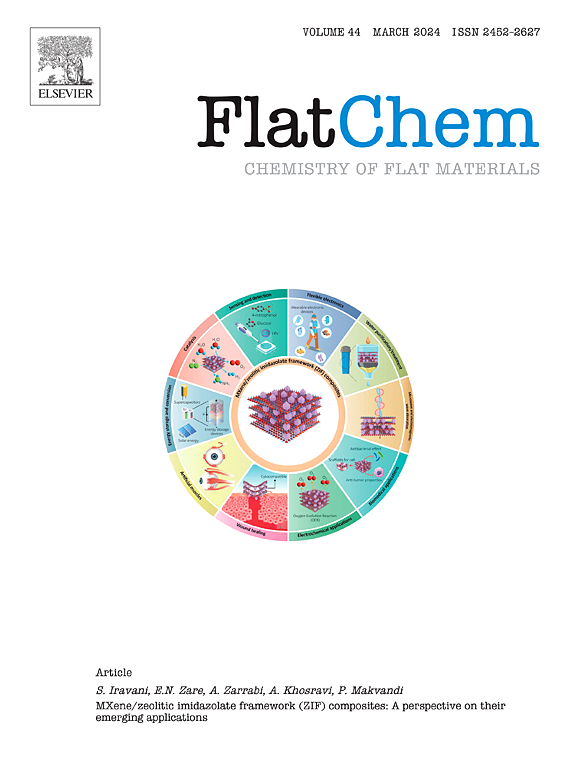基于杂原子掺杂3D V2C MXene纳米花/多孔碳纳米管油墨喷墨打印柔性尼古丁传感器的研究
IF 6.2
3区 材料科学
Q2 CHEMISTRY, PHYSICAL
引用次数: 0
摘要
二维(2D)金属碳化物、氮化物和碳氮化物(MXenes)被认为是喷墨打印中碳基二维材料的有效替代品。另一方面,低抗氧化性和易受堆积问题的影响,使得开发具有3D结构的新型mxene材料至关重要。在此,我们开发了由氮和硫共掺杂(V2C MXene纳米花(Nf)/多孔多壁碳纳米管(h-MWCNT))组成的高稳定性水性油墨。采用简易超声处理和不加模板的冷冻干燥工艺合成了平均粒径为284.6±78.8 nm的V2C MXene Nf结构。将3D V2C MXene结构与多孔MWCNTs混合以增强MXene的氧化稳定性。此外,与原始的MWCNT混合材料相比,在MWCNT结构中创建孔增强了油墨的可印刷性,并显著提高了印刷传感器的电化学性能。将油墨喷墨印刷在柔性基板上,用于制造电化学传感器。测定了印刷传感器对尼古丁的电催化活性。结果表明,我们的新型印刷传感器设计在线性范围(10-500µM)和LOD(0.058µM)方面比已经报道的传感器表现得更好。本文章由计算机程序翻译,如有差异,请以英文原文为准。

Development of flexible nicotine sensors by inkjet printing of heteroatom-doped 3D V2C MXene nanoflower/holey carbon nanotube-based inks
Two-dimensional (2D) metal carbides, nitrides, and carbo nitrides (MXenes) are considered potent alternatives to carbon-based 2D materials for inkjet printing. On the other hand, the low oxidation resistance and vulnerability to restacking issues make developing novel MXene-based materials with 3D structures essential. Herein, we developed highly stable aqueous inks consisting of Nitrogen and Sulphur-codoped (V2C MXene nanoflower (Nf)/holey multiwalled carbon nanotube (h-MWCNT)) hybrids. The V2C MXene Nf architectures with an average particle size of 284.6 ± 78.8 nm were synthesized using a facile ultrasonic treatment followed by a freeze-drying process without any template. The 3D V2C MXene architectures were mixed with holey MWCNTs to enhance the oxidation stability of MXene. Furthermore, creating holes in the MWCNT structure enhanced the printability of the inks and boosted the electrochemical performance of the printed sensors significantly compared to pristine MWCNT-based hybrids. The inks were inkjet printed on flexible substrates to fabricate electrochemical sensors. The electrocatalytic activity of the printed sensors was assessed against nicotine. The results indicated that our novel printed sensor design performed much better than already reported sensors in terms of linear range (10–500 µM) and LOD (0.058 µM).
求助全文
通过发布文献求助,成功后即可免费获取论文全文。
去求助
来源期刊

FlatChem
Multiple-
CiteScore
8.40
自引率
6.50%
发文量
104
审稿时长
26 days
期刊介绍:
FlatChem - Chemistry of Flat Materials, a new voice in the community, publishes original and significant, cutting-edge research related to the chemistry of graphene and related 2D & layered materials. The overall aim of the journal is to combine the chemistry and applications of these materials, where the submission of communications, full papers, and concepts should contain chemistry in a materials context, which can be both experimental and/or theoretical. In addition to original research articles, FlatChem also offers reviews, minireviews, highlights and perspectives on the future of this research area with the scientific leaders in fields related to Flat Materials. Topics of interest include, but are not limited to, the following: -Design, synthesis, applications and investigation of graphene, graphene related materials and other 2D & layered materials (for example Silicene, Germanene, Phosphorene, MXenes, Boron nitride, Transition metal dichalcogenides) -Characterization of these materials using all forms of spectroscopy and microscopy techniques -Chemical modification or functionalization and dispersion of these materials, as well as interactions with other materials -Exploring the surface chemistry of these materials for applications in: Sensors or detectors in electrochemical/Lab on a Chip devices, Composite materials, Membranes, Environment technology, Catalysis for energy storage and conversion (for example fuel cells, supercapacitors, batteries, hydrogen storage), Biomedical technology (drug delivery, biosensing, bioimaging)
 求助内容:
求助内容: 应助结果提醒方式:
应助结果提醒方式:


